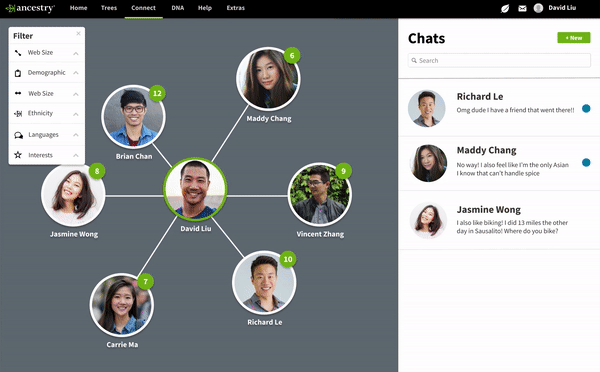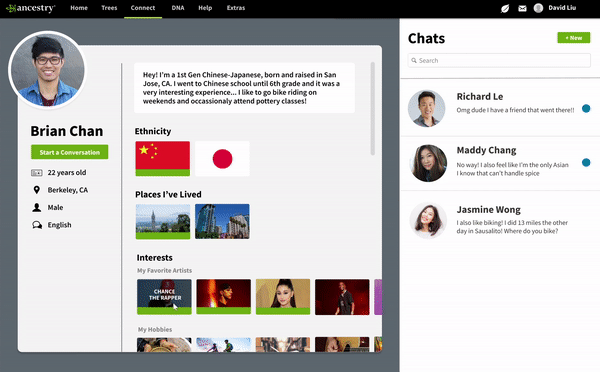
Ancestry x Berkeley Innovation
Ancestry Connect: A safe space to discuss ethnicity and self-identity
ROLE
Contracted Design Consultant, Ideation Lead
TIMELINE
Sept - Dec 2019
DISCIPLINE
User Research, Product Design, Interaction Design
Background
Ancestry is a genealogy company that helps its users understand their family history. Their services include building a family tree and exploring ethnic origins and connecting with people that share common ancestors with through a DNA test.
Since Ancestry’s largest user base consists of older generations, they wanted to expand their services and understand how young people interact and engage with their own ethnic identities. The focus was put on Gen Z and Millennial users, as it was found the engagement of these specific age groups significantly tapered off soon after initially receiving DNA testing results.
Thus, we asked the following question:
How might we foster a safe space for Gen Z and Millennials that enables authentic self-representation and honest social interactions?
Final Solution
To answer the question, we proposed Ancestry Connect, a social space that facilitates purposeful conversations about ethnicity and identity with those who share experiences and similar interests with each other.
Home Page
The main page displays a web of connections of various profiles that the user has the most similarities to, based on a quantified number drawn from user profiles. Upon clicking on a profile, information relevant to how people self-identify is displayed.
In order to further personalize who the user wishes to see displayed, there is an option to filter specific groups of profiles based on different criteria.
We found that individuals connect with others best in a community where they have shared values and experiences. Not only do people relate to each other on the basis of background, but also through similar interests.
Conversation Starters
In order to prompt users to actually connect with different people, there are a list of various conversation starters to choose from. Users are able to bookmark their favorite ones, as well as refresh the auto-generated list.
A common problem with websites that encourage people to meet and connect with each other is the lack of authentic engagement. By creating conversation starters that prompt people to talk about any similarities and deeper shared values, we are sparking authentic conversations about identity in a safe space.
Wait a sec, how did we draw these conclusions?
Let’s see the process. 🠓
Research
For our research, we primarily directed our research towards the target demographic of Gen Z and Millennial user groups. Our survey and interview questions were created to gain an understanding of how young people perceive, value, and engage with their ethnic identities and communities.
Secondary & Market Research
We started off by researching any existing social platforms that existed in the market and common ways people engage with their own ethnic identities online. Some valuable examples we found included:
“Subtle Asian Traits”: a Facebook group with 1.9 million+ members that interact via relatable memes, discussions, and posts about growing up as an Asian in the 21st century
23AndMe forums: where members gather to talk about their own ethnic identities and interesting discoveries made about their genealogy and ancestry
Survey
To gain quantitative data on how people connect with their own ethnic identities, we created a survey via Google Forms that received 100+ responses. We created questions that asked people to think about their relationship and connectedness to their own identities.
1-on-1 Interviews
We conducted 15 interviews with people of diverse ethnic backgrounds and generations to gain insight into personal experiences of how people perceive their own identity.
Insights
After conducting research, we affinity mapped the information gathered from our survey responses and interviews to gain 5 high level insights of how target users connect with their self-identities and ethnicities.
1. Ethnicity is often secondary when searching for a community.
2. College provides an opportunity to become more culturally aware.
3. Homogeneous environments can provide an immediate sense of belonging.
4. Language is one of the most valuable ways to connect with any culture.
5. Environment of upbringing impacts self-concept and can lead to feelings of not being “enough” of one’s own ethnicity.
User Personas + Journey Maps
To understand our target users’ experiences, we created 4 ethnically and generationally diverse personas as well as their respective experiences with identity from early childhood to college. The personas were created by generalizing the many arrangements of generation, ethnicity, and upbringing.
Ideation
Creating safe-spaces for discussion
After conceptualizing our key insights from our research, we spent a lot of time brainstorming as many concepts as possible. Through multiple affinity mapping sessions, we had 50+ concepts.
For each idea we came up with, we tried to focus on the creation of safe-spaces to encourage comfortable and open discussions of personal stories between users of their ethnic backgrounds.
We narrowed down our concepts to a top 3, based on a 2x2 matrix of impact and feasibility.
1. Ancestry University
A non-judgmental platform for students to open up about experiences relating to their ethnicity based on prompts and engage with other’s experiences through tags and reactions.
Relevant Insights
College is a turning point of awareness
There is a prevalent feeling among all ethnicities of not being “_____” enough
2. Identity Web
A social media platform that connects similar people based on how they self-identify, whether that be ethnicity, hobbies, or aspirations.
Relevant Insights
College is a turning point of awareness
Explores openness to others’ stories and potential to relate on feelings such as “not enough”
3. Language Exchange
Learn a language by speaking to a native speaker to exchange not only language but culture as well. Users can chat, call, or send written messages to each other.
Relevant Insight
Language is the most genuine way to connect with culture
* Inspired by the HelloTalk app
Final Concept + Iteration
For our final concept, we decided to further develop the Identity Web concept. This would be a social platform that features a visual “web of connections” of people most similar to you based on interest and ethnic background.
From our research and insights, we found that people most valued connecting with others based on shared values, experiences, and interests. We felt that this concept was the most relevant in terms of this sentiment.
Low Fidelity Iterations
After confirming our concept, we sketched low fidelity wireframes of what the platform would look like.
We went through 3 rounds of iteration on what the concept would look like and 2 rounds of concept feedback on 6 users where we tested the general flow, visual presentation, usability, and the usefulness of features.
User Flow
To get a general idea of how a user would navigate the web of connections and interact with other users, we mapped out a user flow. This helped us visualize possible interactions that users would have. We were able to identify possible corner cases and specific situations, such as thinking about refreshing the different connections displayed to the user.
Concept Validation
Before we fully committed to the concept and designed our prototypes, we wanted to validate that a “web of connections” was the best visualization.
To do this, we recruited 5 UC Berkeley students who had no prior background on the project. We walked them through our concept and its general flow without showing them any imagery or alluding to a “web” to avoid any preconceptions and bias. Then, we asked them to draw what they thought the best visualization of this concept would be.
To our surprise, a majority of those we interviewed imagined some sort of web-like shape to visualize these various connections.
So, a web of connections it was.
Value Proposition
Why Ancestry Connect?
While we already validated the web of connections, specifically, Ancestry Connect as a platform facilitates purposeful conversations about ethnicity and identity between people who share similar interests and experiences.
It addresses the shortcomings of Ancestry’s existing family connection platform for those who may have limited matches based on shared ancestors. All users can now cultivate meaningful relationships beyond genetics through how they self-identity.
Results
We presented our findings in a final presentation to the design team at Ancestry. They were very pleased with all of the insights we gathered, being surprised at the sentiments and relating to feelings of identity that many respondents had. Our idea of a “web of connections” received a positive response, because it was very similar to the business model at Ancestry of genealogy and connection. We were told that the research we gathered from this project was very helpful as they will continue to develop a platform for younger Ancestry users to engage with each other based off of our insights.
Reflection
Overall, this project was a great learning experience for me, as it was my first time working with clients in a sprint-based design project. I think the problem space that we worked in was eye-opening in terms of sparking deeper conversations about ethnic identity and self-representation. It felt very relatable as a first-generation Asian American, and the insights we gained from our research felt impactful and relevant.
In the future, I hope to be able to create more in-depth and higher-fidelity interactions to better showcase the different
I’m really grateful that I was given the opportunity to work on this amazing project with my team. Thank you to our clients for being so encouraging and helpful throughout the entire project!













